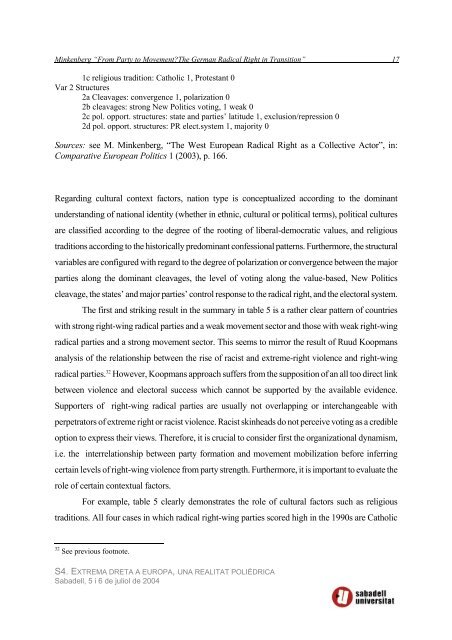From Party to Movement? The German Radical Right
From Party to Movement? The German Radical Right
From Party to Movement? The German Radical Right
You also want an ePaper? Increase the reach of your titles
YUMPU automatically turns print PDFs into web optimized ePapers that Google loves.
Minkenberg “<strong>From</strong> <strong>Party</strong> <strong>to</strong> <strong>Movement</strong>?<strong>The</strong> <strong>German</strong> <strong>Radical</strong> <strong>Right</strong> in Transition” 17<br />
1c religious tradition: Catholic 1, Protestant 0<br />
Var 2 Structures<br />
2a Cleavages: convergence 1, polarization 0<br />
2b cleavages: strong New Politics voting, 1 weak 0<br />
2c pol. opport. structures: state and parties’ latitude 1, exclusion/repression 0<br />
2d pol. opport. structures: PR elect.system 1, majority 0<br />
Sources: see M. Minkenberg, “<strong>The</strong> West European <strong>Radical</strong> <strong>Right</strong> as a Collective Ac<strong>to</strong>r”, in:<br />
Comparative European Politics 1 (2003), p. 166.<br />
Regarding cultural context fac<strong>to</strong>rs, nation type is conceptualized according <strong>to</strong> the dominant<br />
understanding of national identity (whether in ethnic, cultural or political terms), political cultures<br />
are classified according <strong>to</strong> the degree of the rooting of liberal-democratic values, and religious<br />
traditions according <strong>to</strong> the his<strong>to</strong>rically predominant confessional patterns. Furthermore, the structural<br />
variables are configured with regard <strong>to</strong> the degree of polarization or convergence between the major<br />
parties along the dominant cleavages, the level of voting along the value-based, New Politics<br />
cleavage, the states’ and major parties’ control response <strong>to</strong> the radical right, and the elec<strong>to</strong>ral system.<br />
<strong>The</strong> first and striking result in the summary in table 5 is a rather clear pattern of countries<br />
with strong right-wing radical parties and a weak movement sec<strong>to</strong>r and those with weak right-wing<br />
radical parties and a strong movement sec<strong>to</strong>r. This seems <strong>to</strong> mirror the result of Ruud Koopmans<br />
analysis of the relationship between the rise of racist and extreme-right violence and right-wing<br />
radical parties. 32 However, Koopmans approach suffers from the supposition of an all <strong>to</strong>o direct link<br />
between violence and elec<strong>to</strong>ral success which cannot be supported by the available evidence.<br />
Supporters of right-wing radical parties are usually not overlapping or interchangeable with<br />
perpetra<strong>to</strong>rs of extreme right or racist violence. Racist skinheads do not perceive voting as a credible<br />
option <strong>to</strong> express their views. <strong>The</strong>refore, it is crucial <strong>to</strong> consider first the organizational dynamism,<br />
i.e. the interrelationship between party formation and movement mobilization before inferring<br />
certain levels of right-wing violence from party strength. Furthermore, it is important <strong>to</strong> evaluate the<br />
role of certain contextual fac<strong>to</strong>rs.<br />
For example, table 5 clearly demonstrates the role of cultural fac<strong>to</strong>rs such as religious<br />
traditions. All four cases in which radical right-wing parties scored high in the 1990s are Catholic<br />
32 See previous footnote.<br />
S4. EXTREMA DRETA A EUROPA, UNA REALITAT POLIÈDRICA<br />
Sabadell, 5 i 6 de juliol de 2004













